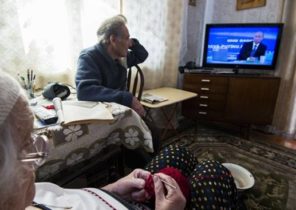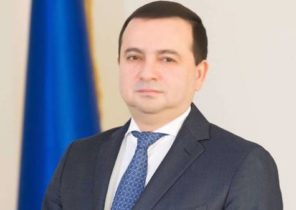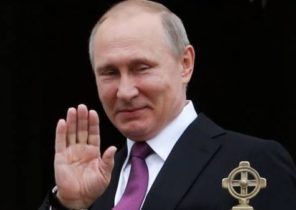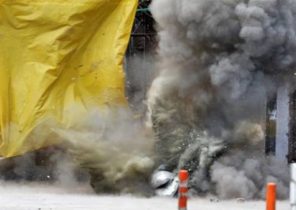
On the eve of the International day of remembrance of the victims of the Holocaust UNIAN talked with a researcher of the Ukrainian centre for the study of the history of the Holocaust Mikhail Tax.
International day of remembrance of the victims of the Holocaust — the mass persecution and extermination of the Jewish people by the Nazis of the Third Reich. According to official statistics, the Holocaust has lost the lives of nearly 6 million Jews, about 1.5 million of them died in Ukraine. Ukrainian historians often compare the Holocaust with another, the same inhuman tragedy of the last century — the Holodomor. Artificially created, planned state regimes brutal “action,” which claimed more lives than military action. On the eve of the International day of remembrance of the victims of the Holocaust researcher of the Ukrainian centre for the study of the history of the Holocaust Michael Taxpaying told UNIAN extermination of Jews in Ukraine, should our government be held responsible for the tragedy, and what conclusions should we draw from history to prevent its recurrence.
Historians still argue about the beginning of the Holocaust. Some experts say that the total destruction of the Jews began in the summer of 1941 in Ukraine, others remind that in the 30’s in Berlin happened pogrom known as “Kristallnacht”. What position tends to stick to you?
— I am inclined to the view, which, incidentally, shared by the majority that the most important change in the attitude of the Jews happened on 30 January 1933, when Adolf Hitler and the National socialist party gained power and access to the state machine in Germany. Until January 30, there was anti-Semitism of the individual parties after anti — Semitism became part of public policy. Not all historians tend to put an equality sign between the Holocaust and the “final solution of the Jewish question” (extermination of the Jewish people — UNIAN), because the policy of Nazi Germany for 30 years was a search for the answer to the dilemma of how to solve the Jewish question? The Nazi Reich was not a monolithic state system, there were different groups, so there were different approaches to addressing — to facilitate the emigration of Jews, to humiliate them in every possible way, to be isolated in society.
The final decision was crystallised in the first two months of the campaign against the Soviet Union, after the implementation of the plan “Barbarossa”. Literally within two months, when, after the regular German army [Wehrmacht], deep into the Soviet territory went to the Nazi death squads, began the destruction of all Jews: men, women, children, the elderly. This policy on the Eastern front, implying total destruction, spread to the rest of the Jews who were in the sphere of influence of Nazi domination. As you know, German women were often married to Jews.
— What was Nazi policy towards these men?
The policy was softer, people could not be a definite deportation to the East or to the death camps, as were those who were recognized as 100% Jews. While in the Soviet occupied territory, the policy was still hard. That is, if it was about the child from a mixed family, the vast majority of cases, it is still subject to “special treatment”, like his Jewish parents.
— A symbol of the struggle during the Holocaust is the uprising in the Warsaw ghetto in April-may 1943. Why is this rebellion?
Is the most extensive and well described in the literature of resistance, which left a lot of documentary evidence, and that is why it has acquired a symbolic meaning. Such uprisings were not one, not two, but they are very poorly studied. First, there is a good evidence base.
Second, if we consider the territory of the Soviet borders of 1939 year, there is a Jewish community already did not exist as such. In the 1920s, and, especially, in the 1930s, all the national organizations and community structures have been eliminated, suppressed religious life and the Jews have not had leaders who could organize opposition.
The tragedy of Babi Yar is the first thing that comes to mind in the context of the discussion of the Holocaust in Ukraine. About how many people died, the debate is still going? According to reports of the Nazi punitive group during this “action” (as it was called by the Germans), on 29-30 September 1941, in Kiev were killed 33 771 Jews. It is clear that to reach this “action” the Germans managed not all, a huge number of people were hiding. Today, there are more or less established view among historians that the total number of victims of the Jewish population in Kiev was approximately 70 thousand people. Thus, the total number of victims of Babi Yar, which, as you know, killed not only Jews — about 100 thousand people. At Babi Yar, people were shot, but it was not the only method of destruction. The Nazis threw the Jews into pits alive, poisoned by poison, drowned, dismembered…
— Is it fair to say that Babi Yar is the most cruel tragedy in the Holocaust in Ukraine?
— I don’t like to say that any tragedy was more violent and some less. Even the murder of one person — this cruelty. Another issue is that this monstrous “offer” was the biggest.
However, there were others, for example, in Kamenetz-Podolsk, where a few weeks have shot about 23 thousand Jews. In fact, the whole occupied territory of the USSR, regardless of, have killed 100 people or tens of thousands of people, reminds one big repetitive at different scales Babi Yar. This was due to the fact that the occupied Soviet territories, in particular, on the lands of Ukraine, the Holocaust was not accustomed to thinking in Western Europe — where the history of the Holocaust was included in the collective historical consciousness in Auschwitz with gas chambers and crematoria. In the Soviet Union murder of Jews took place, mainly by shooting. It is estimated that in General victims of the Holocaust in Ukraine was approximately one and a half million Jews, of which about a million and a hundred thousand were killed, and up to 400 thousand (mostly it was the residents of Western Ukraine) were deported to the death camps.
— How many people in the Holocaust were killed in Europe?
— A few decades ago in the collective mass consciousness has established the figure of 6 million. Of course, it is not accurate, but scientific studies say about the size from 5.7 million to almost 7 million people — the question is constantly raised and reviewed, which is normal for scientific research. That is, the number of victims is diverse, ever-changing statistical picture. In one place we learn something and the official number of victims is decreasing, the other something else- and it’s growing, unfortunately. For example, in the first year after the war, during the Nuremberg Tribunal cited the figure that Auschwitz had killed 4 million people. However, today we know that the total number killed at Auschwitz is somewhere 1 million 100 thousand, of which about 900 thousand is Jewish victims.
The Holocaust is a terrible historical memory for Europe. Did he become, today, the historical memory of Ukrainians?
It is a very difficult question. Not least because the very notion of “historical memory” can be understood in different ways. We are talking about official government policy, or collective memory, or the memory of the descendants of the victims?— The answer will be different. I would say about communicative and cultural memory. For many decades during the Soviet era and even during independence, the Holocaust remained a phenomenon that was in the spheres of communicative memory. That is, any information received by the family members of witnesses, but as part of cultural history (in textbooks, Museum exhibits, literature, films) the Holocaust never happened. Now the situation is gradually changing due to a number of factors. Back in 2000, the year Prime Minister Viktor Yushchenko attended the international forum on history teaching and the perpetuation of the memory of the Holocaust, which adopted the Stockholm Declaration, you need to remember the Holocaust and teach it (in 2005-m was adopted by the second document of this kind). Thus, Ukraine has become one step further to join these processes. In our school there was a term “the Holocaust” and the alleged history gradually becomes part of the cultural memory (which is a great merit of non-state organizations). However, in school curricula is still very little attention is paid to the Holocaust, and in most textbooks — the problem with the explanation of the tragedy. Usually the explanation is not in the child forms the idea that anti-Jewish policy of the Nazis was total destruction. Fact anti-Semitic Nazi ideology that considered the Jews not just as second class citizens (as it is considered, for example, of the Slavs), but as “creatures that only look like humans” are most often not explained. At the same time, the history of the Holocaust can fit not only the historical rate. Along the way you can attain some of the educational challenges associated with the perception of empathy, citizenship, understanding of what moral choices and ethical categories…
— What do you think, is there a certain percentage of Ukrainians who do not know anything about the Holocaust? In any society there are always people totally indifferent to historical issues. However, the overall presentation of the Holocaust deeper spread. For example, the 75-year anniversary of the tragedy of Babi Yar (September 2016 — the UNIAN) got really unprecedented attention from the media, public bodies and senior officials. So, I think the number of totally informed people reduced.
In Soviet history, the word “Holocaust” did not exist. However, as the word “famine.” Many experts carried out between the Parallels. For example, Yaroslav Hrytsak has an article titled “the Holocaust and the Holodomor: challenges to collective memory”. Can you compare these two tragedies? In the academic literature adopted the term “genocide” to refer to a variety of mass tragedies, which were national, religious, ethnic soil in the 20th century. If you operate this term, there is reason to come to the conclusion that at a certain stage of history, in early 1933, the year for the Kremlin leadership, “Ukrainian issue” has ceased to be simply a question of overcoming the resistance of collectivization — it has become a national issue. In this respect, the story of the famine has every reason to be qualified as genocide. If we draw Parallels between the Holodomor and the Holocaust, we can see that there are quite a few external Parallels and structural similarities. First, we see that the implementation of this process involved the state regimes. At the same time, they were guided by their own ideology (the Nazis — the superiority of the Aryan nation and the alleged right to reconfigure the world; the Bolsheviks — the desire to reorganize society on the basis of class ideological criteria). So, there are both similarities and differences.
— There is an international day of remembrance of the victims of the Holocaust, the Holodomor recognized as genocide is not so much countries. For example, Israel is not recognized, despite the announced last fall promises. This attitude is, shall we say, disappointing. What do you think about this?
— I don’t want to take any one of the parties in matters of recognition by the parliaments of such or such phenomena in terms of assigning legal shortcuts. As a historian, I would prefer to ignore the modern processes of recognition or non-recognition, bordering often with speculation, with political circumstances of international policy. If someone believes that, for example, the story of the Holodomor as genocide or the Holocaust have been recognized at the political level, some parliaments, it is your task, please implement. My goal is not to hang any label on the phenomenon, and to try to describe and understand what was its cause, consequence, or whether it is, God forbid, be repeated. Last year on the eve of the 75th anniversary of the Babi Yar tragedy President of Israel accused the Ukrainians, in particular, the fighters of the OUN in complicity with the murderers of Jews during the Second world war. Should the independent Ukraine as a state is to some extent responsible for the tragedy? Legal liability none of today’s political entities can not carry. Here the question of historical responsibility. One historian has so well said: “We are not responsible for the past, we are responsible for the memory of the past”. The liability issue is identity: who we are today, how we present our values? Historians openly declare that objective history does not exist, and we will design it depending on our goals, beliefs and direction of movement.
For example, if we want to live in mono-ethnic state, which would be built on the principle of ethnic nationalism, the history, we will reconstruct in appropriate way: to see heroes who tried to achieve their goals by any means, including by eliminating from society those they considered superfluous. If we see our future to be cogs in the huge state machine, we will reconstruct the past appropriately — we will have Great Patriotic war, the great feat of the Soviet people under the wise leadership of the Communist party. If we want our children to live in a society built on inclusive principles, then we will reconstruct the past in this way. Will look for it the characters are not of one political party or ethnic group, and all who have contributed to the development of the world. So in this respect the principle of responsibility is difficult to formulate simply. It does not mean reparations or an apology preneseni officials. Although, incidentally, in 1991, at the time still being the President, Leonid Kravchuk at Babi Yar apologized to the Jewish people for all the wrongs that they received from the Ukrainian people.
— At the end of 2015, speaking in the Knesset, Petro Poroshenko also apologized for the actions of the Ukrainians during the Holocaust. How such steps are valuable from the point of view of historical memory?
— I have a dual attitude. If we’re talking about that today in the Ukrainian public space, in the system of values which we create, some sort of prominent place (in the opinion of some — base) is the Ukrainian national idea, we need to understand how the Ukrainian national idea is perceived by our neighbors. And then we also have to think about it: how we are perceived Ukrainian national idea? If we have some continuity and see our heroes of the brightest representatives of Ukrainian nationalism in the 1930s — 1940s (primarily that of Stepan Bandera, Roman Shukhevych), then we need to imagine and be prepared for the fact that our identity is built on the basis of this today, can be differently perceived by those with whom we want to have good neighborly relations. So, I think this statement could be and probably was useful as a demonstration that we understand our past has been mixed. We must understand that the version of Ukrainian nationalism, which was at the forefront in 30-40 years, and which today is present in our public discourse, it was the people, first and foremost, striving to build an independent state, but in order to achieve these goals, they acted pretty radical and brutal methods. In particular, by excluding from the “ideal society” of those who, in their opinion, had no right to be in this society. And it is also important to understand that such a position does not mean denigration of these figures. In fact, the specifics of official historical and collective memory that the images always glorify and simplified look black and white. But we must not be selective in their approach to the creation of the hero image, otherwise the image will be clear and will not bring us any understanding of the era, nor the understanding of man. If we talk about historical memory, that is the responsibility, I wish we came.
Historian Anatoly Podolsky once said in an interview that the unexamined lessons of the Holocaust have made themselves felt in the East of Ukraine. In particular, he talked about the propaganda and military machine, which was used by Hitler to exterminate Jews, and which is now used by Putin to destroy the Ukrainians. You would have had such Parallels?
— The parallel conduct can and should be in any major historical events. Any historian who studies the history of genocide, I will say that in the process of its implementation, it is more important representation of the executioners of his victims. We see how strong the images created by mass propaganda: how Nazi Germany in the 1930-ies, and in today’s reality, the ideology of “Russian world” — an artificial phenomenon that has no historical basis. What is there here that in other similar processes — we are talking about the construction of reality and mobilize people who would be guided by these views and have made certain actions on the basis of them. So, Parallels, unfortunately, a lot.
Of course, primitive and it would be foolish to say that everything that happens to us is the consequences of not learned lessons of the Holocaust. However, we should pay more attention to arts education, particularly in working with children, critical thinking skills, the ability to distinguish between imposed values from their own. The Holocaust was the result of a lack of such skills among a huge number of representatives of the German people. What is happening today not only in the Donbass, in General, in many aspects, also, last but not least, occur for this reason. You once said that you know 1000 places, where during the Second world war, there were mass executions of Jews, with about half of them are marked with memorials. What is the situation with memorials in Ukraine? Now the process of memoriali in Ukraine are very active. Much more active than in the other countries of the former USSR. For example, in Belarus and Russia, the new monuments are almost there. Our activity is due to different reasons. Firstly, the Ukrainian historical policy has been a long time (now also) is decentralized. The local political elite and the population involved in its formulation, and the Central leadership chose not to interfere, not to split Ukraine.
Secondly, due to the overall situation in the Ukraine during the Second world war Ukrainian historians is treated in a more humane manner. Been an increasing trend in the historiography, which describes the history of the battles and the life of the common man. Third, the impact of the European integration direction of Ukraine.
In the European Union the history of the Holocaust — this really is one of the main components of the historical collective memory, painful for any national historiography. I can’t give an exact number of monuments, it is necessary to conduct a major project in different regions of Ukraine. However, there are very different ways of commemorative (save in the public consciousness the memory of the event, — the UNIAN) the Holocaust in the Ukrainian society. Part of the monuments of the Soviet era, in them we see only with Soviet inscriptions about the civilians that were Zverkov killed by the Nazi occupiers, no mention of Jews or the Holocaust. Other monuments are also Soviet, but a bit redone, with new signs and some specific information. The third kind is completely new objects, which already have Jewish symbols. The problem is that the vast majority of them, in principle, weakly “work” — the local know nothing about them. It often happens that the inhabitants of some regions will know about Babi Yar, but not even hear about what was happening near their settlements.
I am ready with 100% confidence to suggest that there is still not marked [monuments], neglected places. And if we talk about regional specificities, in Western Ukraine such places more than in the Central or Eastern. This is due to the fact that before the arrival of the Germans of the Jews of Central and Eastern regions had to be evacuated, respectively, after the war, more people were returning to their homes. They were so called agents of memory and contributed to the perpetuation of Jewish victims. In Western Ukraine, more Jews were killed (due to the fact that the German attack came as a surprise to the Soviet military leadership), and those who survived usually moved.
That is, these people, the agents of memory and were the initiators of the appearance of monuments or memorial plaques?
— In the Soviet Union, it happened like this: the relatives of the victims gathered informally cooperated with the authorities to build at least some form of monument, the authorities often went to meet. After the collapse of the Soviet Union began the second wave. From abroad came the relatives of the victims, sometimes even the survivors themselves wanted to show their native land and came with their children and grandchildren. And, again, interacted with the local authorities. The very power of such things is almost never initiated. And still, to a large extent, remains the need for some impetus from the outside.
— What, in your opinion, the Holocaust should teach society, in a global sense?
— Let’s just look at the educational process. If we teach children facts and figures: in that year something happened, it was so many victims and nothing else — the children, nothing to say and they will not be recovered from the history lesson.
It is important to learn to look at history through the eyes of the person with whom this happened, looking through documents, sources. A young man must learn by committing some act, be aware of motivation and its responsibility for this act. He needs to learn to act not under the influence of the perceived conventional values and opinions, and guided by internal motivation.
— You are talking about the young generation, and how to encourage adults to look at the story critically?
— I wouldn’t exclude adults from this educational activity. For example, we have projects we work on with teachers. Taking part in our seminar, they are then adjusted or an entirely new look at the history of the Holocaust in particular and in General on the way of understanding history.
— What motivated you personally to start learning of the Holocaust?
After graduating from the Simferopol state University in 1996 I couple of years worked with “Spielberg Foundation”, which is then worldwide recorded interviews of witnesses of the Holocaust. For them I wrote about a hundred of video footage, and then realized that in scientific terms this topic is actually explored, gradually deepened, and since then working in it.
— Was there anything in the testimony that struck you?
I always tried to build an emotional barrier between myself and the interviewees, but one could not resist and cried. A man aged somewhere around 70 told how [the Nazis] took away his parents.
He himself was not at home then — roommate hid the boy. And now the man remembered the moment when she learned that parents are no more, and his face began to look quite childish. Psychologists know that people, especially the elderly, telling about traumatic incidents from their distant past, emotionally really turn into kids and the face it shows.
For me it was a very difficult time, and there were many such cases…







